If you're putting your wetsuit away for any length of time you want to store it properly so that it lasts and doesn't get damaged over the long days in storage.
There are a variety of good storage options available for your wetsuit and you can pick the one that best suits you. But before you throw your wetsuit in a box or drawer to be forgotten about for a season or 2 it's first EXTREMELY important you dry your wetsuit quickly.
The Most Important Thing When Storing A Wetsuit – Drying It Completely
Before you pack your wetsuit away it is imperative that you completely and utterly dry your wetsuit ahead of time. This includes drying the inside as well as the outside.
Many times I myself have left my wetsuit to dry in a shady area like over my bath for a few days and it feels dry to touch (on the outside at least).
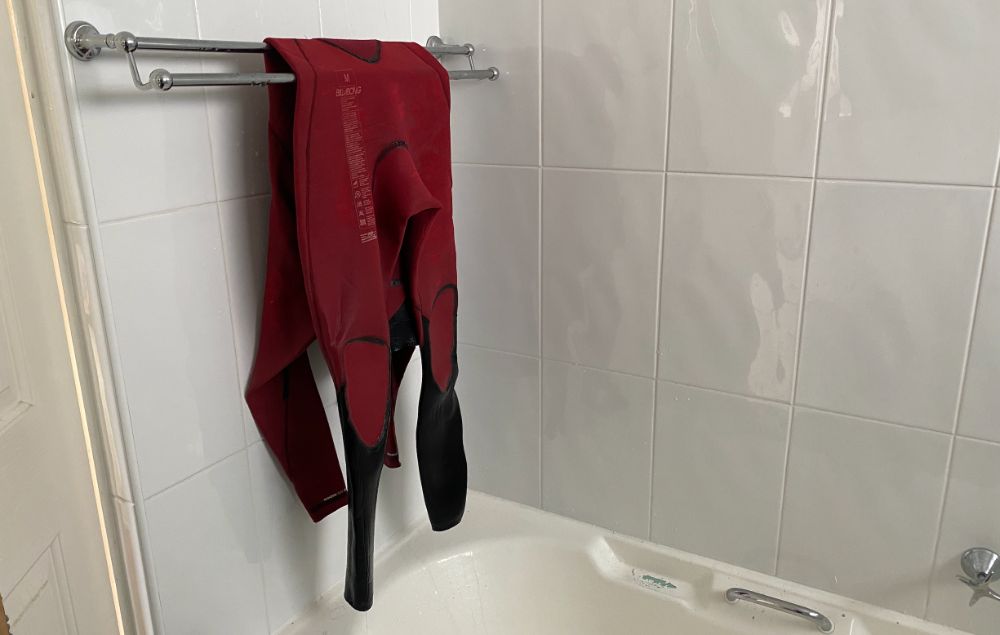
However, if you then go to turn your wetsuit inside out you may notice that the inside of the wetsuit is still damp.
If you were to store your wetsuit after only drying one side at best you'll end up with a pretty smelly wetsuit after a few months of storage and at worst you'll end up with a wetsuit that is full of mold.
While I don't recommend you put your wetsuit in the dryer I do recommend you dry both sides of your wetsuit thoroughly before putting it into storage and double check that the wetsuit is completely dry before storing it away. I've got tips on how to dry wetsuit boots and how to dry wetsuit gloves too if you're storing them away.
Now that your wetsuit is completely dry here are 6 of the best ways to store your wetsuit for the long haul:
1. Use a Wetsuit Hanger in a Closet
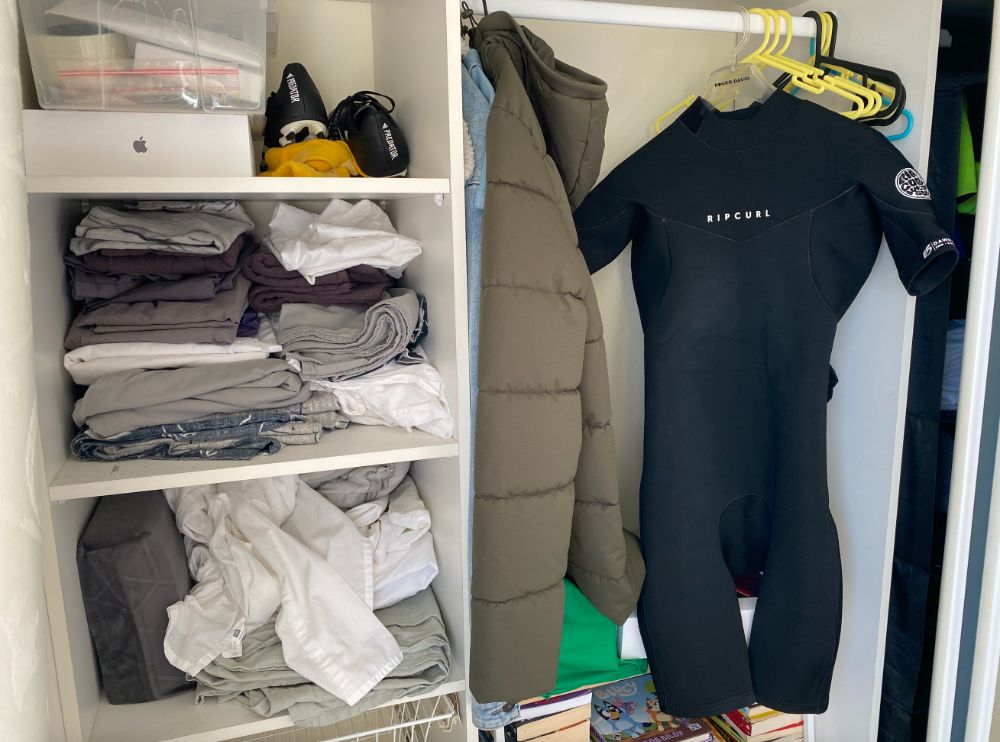
One of the simplest and best ways to store your wetsuit for the long term is to hang it up in your closet. However, you ideally want to avoid thin clothes hangers as the weight of the wetsuit over time can pull on the thin hanger and cause the shoulders to stretch.
You want to get a wide hanger or specifically a wetsuit hanger that will spread the weight over the shoulders and stop this stretching.
Wetsuit hangers utilize specific designs explicitly for the weight and material of a wetsuit. They’re made for both drying and storage, so it’s one of the easiest and most convenient ways to store a wetsuit. Click here to see my full list of the best wetsuit hangers on the market.
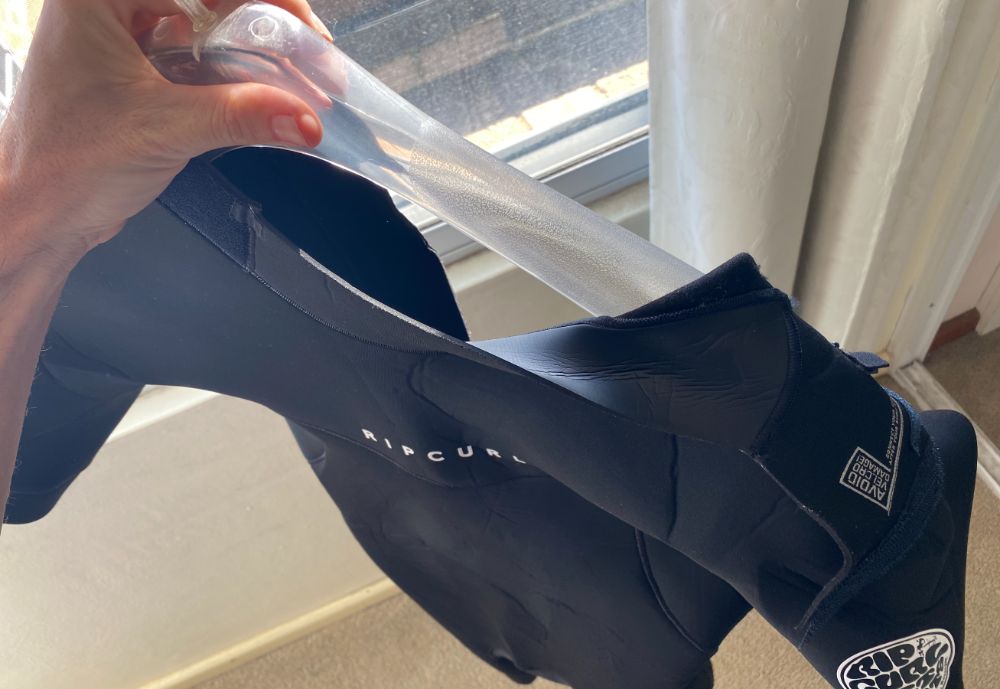
A wetsuit hanger uses extra-wide “arms” to equalize the pressure on the neoprene or rubber. Additionally, the hanger better supports the shoulders, reducing any stress points that lead to holes, rips, and stretching over time.
Here’s how to use a wetsuit hanger for long-term storage of a wetsuit:
- Rinse the wetsuit thoroughly, both inside and out. You may also need to wash it with a wetsuit-safe detergent. Do not skip this step, as saltwater, sweat, and body oils may degrade the material over time.
- Hang the suit by the shoulders. Store it in a well-ventilated space until it’s completely dry. You may point a fan at the wetsuit, if possible, to speed up the drying process. Alternatively, there are wetsuit hangers with built-in drying fans available. I recommend the Underwater Kinetics HangAir Hanger on Amazon. The built-in fan significantly reduces drying time.
- Store the clean, dry wetsuit while still on the hanger in a closet. Keep it away from direct sunlight to protect the material.
Drying a wetsuit may take several hours or days, depending on the current temperature and humidity.
Don’t hang a wetsuit by the shoulders on a standard hanger, as they’re not designed to withstand the weight of a wetsuit and may cause creasing.
DIY Wetsuit Hanger
If you’re in desperate need of a wetsuit hanger right now, you can create one at home. This DIY hanger isn’t ideal for long-term storage, as wire hangers aren’t designed to withstand such heavy weight, but it works in a pinch if you need to dry your wetsuit before storing.
Here’s what you’ll need to create a wetsuit hanger:
- Screwdriver
- Strong hanger (avoid wire)
- Foam pipe insulation, or an old pool noodle
- Zip ties or duct tape
Create the wetsuit hanger using these steps:
- Poke a hole in the center of the foam using a screwdriver.
- Slide the hanger hook through the hole that you created with the screwdriver.
- Use zip ties or tape to secure the foam to the “arms” of the hanger.
- Snip off the excess zip tie pieces, if necessary.
The foam adds extra surface area, spreading the weight of the wetsuit more evenly. With that said, most standard hangers are pretty flimsy compared to the stainless steel and resins used to design most wetsuit hangers.
As such, you should use the DIY hanger for drying only, not long-term storage.
2. Place the Wetsuit in a Plastic Bag (Ideally Airtight)
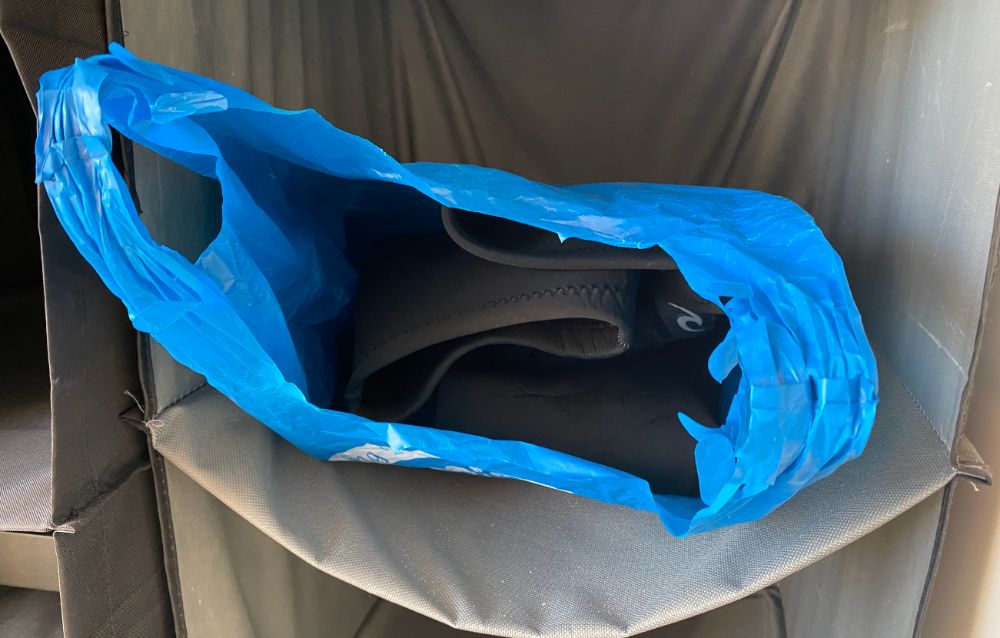

An airtight plastic bag or container ensures that you don’t expose the neoprene to dust and other contaminants, and it allows for easy storage under a bed or in a closet. But honestly, any plastic bag will do assuming your wetsuit is dry.
An airtight plastic bag is one of the best options for wetsuits when you don’t have a wetsuit hanger because rubber and neoprene are susceptible to air degradation.
Here’s how to properly store a wetsuit using airtight vacuum-sealed bags:
- Wash, if necessary, rinse and dry the wetsuit. Ensure that you wash and/or rinse both inside and out.
- Roll the dry wetsuit up. Do not fold the wetsuit, as this leads to creasing and the breakdown of the neoprene or rubber.
- Place the wetsuit in a vacuum-sealable plastic bag. I recommend the Spacesaver Premium Vacuum Storage Bags, available at Amazon. The set includes six vacuum storage bags and a travel pump. Each bag employs a double-zip seal to allow for easy removal of all air.
- Remove the air from the bag. Using a pump or a vacuum cleaner, suck the air out of the bag until it completely encases the rolled-up wetsuit.
Once you’ve vacuum-sealed the wetsuit, store it away under a bed, in a closet, or in another cool, dry place.
The great thing about space saver vacuum bags is they cause your wetsuit to take up less storage space than it otherwise would, meaning it's easier to store.
If you don't have a vacuum bag then a regular plastic bag will do just fine. Fold or roll up your wetsuit, place it in the bag and tie it up. Push all the air out before tying it up tight. This will protect it from most air exposure and saves you buying vacuum bags if you're too lazy (like me)
3. Store the Suit Laying Flat

One of the best ways to preserve the shape and material is to store the wetsuit completely flat. Of course, this isn’t always the most feasible option, as it requires more space than the other methods mentioned in this article.
If, however, you do have the space to spare, such as in the top of your cupboard on top of some blankets or storage boxes, you should store the wetsuit this way. Not only does it maintain the suit’s overall form, but it prevents creasing, stretching, and cracking over time.
For extra protection use a garment bag and place your wetsuit inside:
Store your wetsuit on a flat surface using these steps:
- Wash, rinse, and dry the wetsuit. Ensure that you’ve cleaned and/or rinsed both the inside and outside of the material.
- Lay the garment bag onto a flat surface. The bag should be large enough to support the entire length of the suit without folding or scrunching.
- Place the fully dried wetsuit into the bag. Do not use a hanger.
- Make sure there are no creases or folds before zipping the garment bag. Smooth over any wrinkles with your hands.
- Zip up the garment bag. Do not place any objects on top of the garment bag, as this puts stress on the wetsuit.
While the garment bag should protect the wetsuit from dust and UV light, it does not protect against extremely high or low temperatures.
Over time, rubber and neoprene become rigid after exposure to low temperatures, increasing the likelihood of cracks and tears. Heat, too, may affect the overall quality of a wetsuit. Keep the wetsuit in a cool, dry place.
4. Place the Wetsuit in a Box or Other Container
Sometimes, especially when space is a factor, the only option to store a wetsuit is in a box or plastic bin. This allows you to put it in the garage or a place exposed to moisture that you otherwise couldn't store your wetsuit in without fear of it growing mold.
However, you should never toss a wetsuit into a box or bin and call it a day, as this could potentially destroy your wetsuit, and as we all know, they’re not cheap. Unless you plan on paying for an entirely new diving garment, you must take good care of your wetsuit.
Store your wetsuit safely in a box or bin using these instructions:
- Wash, if necessary, rinse, and dry the wetsuit. Ensure that it is completely dry.
- Roll the wetsuit up. Do not fold. Rolling prevents weakening the rubber or neoprene material.
- Place the folded wetsuit in a box or bin. You can store the wetsuit with other items, including other dive gear, but the wetsuit should remain on top.
- Close the box or bin. Store the box or bin in a cool, dry room. Do not store other gear on top of the wetsuit if possible so pressure over time doesn't damage the neoprene.
5. Storage The Wetsuit Folded On a Shelf Or In a Drawer
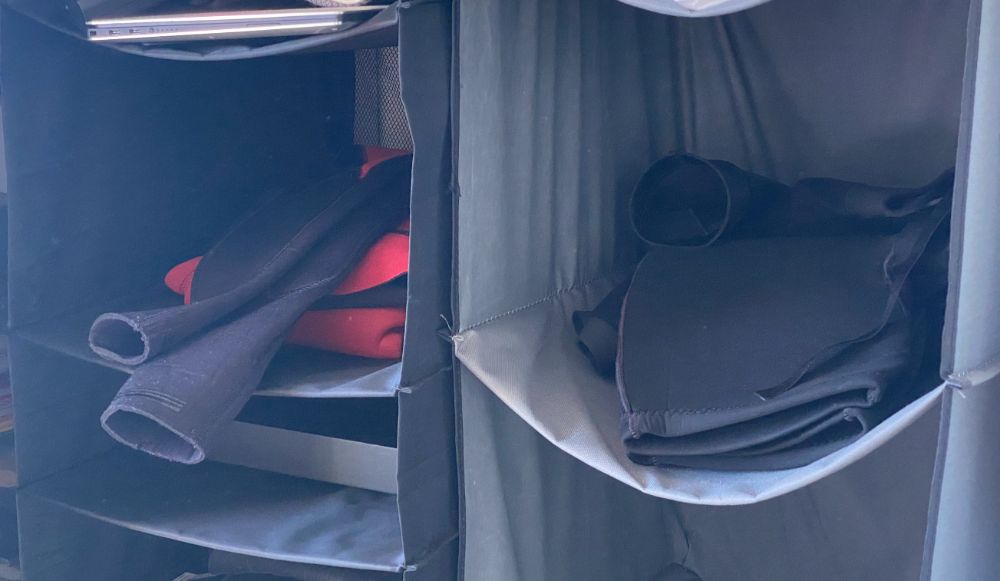
Sometimes the simplest solutions are the best. Folding your wetsuits up like a tshirt and storing them in a shelf or drawer can be a great way to store them without them getting damaged.
The biggest things here are to make sure the wetsuits are completely dry and to not store anything heavy on top of the wetsuit.
If you place a heavy box on top of the wetsuit then it can cause damage to the rubber and neoprene. So keep the wetsuit on top so nothing is pressing down on it.
6. Roll The Wetsuit Up
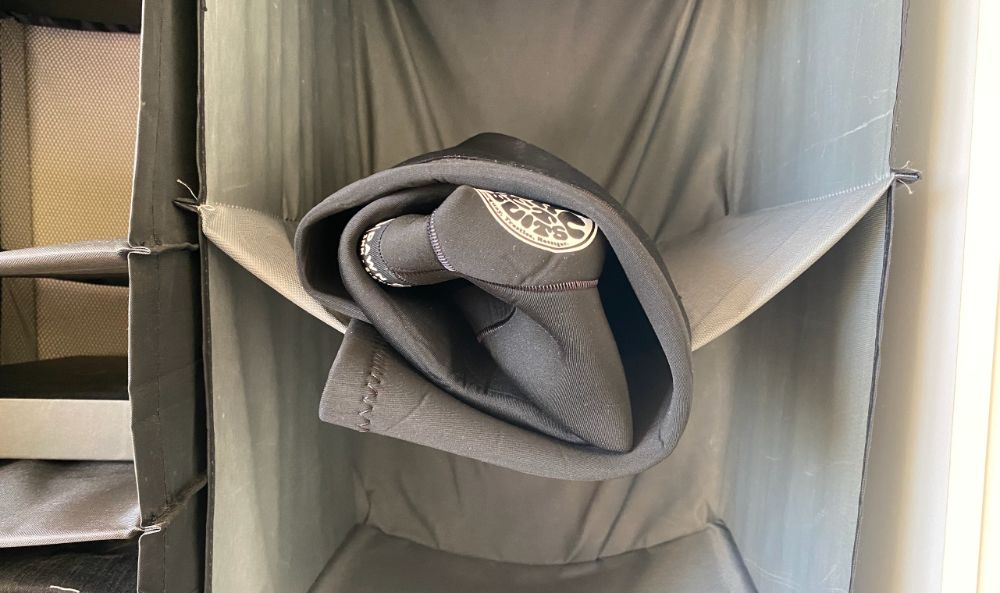
To avoid obvious creases in your wetsuit that come from folding it you can instead opt to roll your wetsuit up once it's dry.
You can then store it on a shelf, in a drawer or even in a bag or box like we've already talked about.
By rolling it up you stop obvious creases from forming which means when it comes time to wear it again it shouldn't look like you just pulled it out of deep storage.
Wetsuit Storage Tips
Now that you know the different ways to store a wetsuit properly, let’s talk about some factors to consider for long-term storage:
- Use only eco-friendly, biodegradable wetsuit detergents. Avoid products that aren’t explicitly designed for wetsuits. These soaps may contain harsh chemicals that degrade the wetsuit or harmful chemicals that adversely affect marine life. Click here for my list of homemade wetsuit cleaners.
- Rinse and dry the wetsuit before storing. If necessary, wash it inside and out with a wetsuit-safe detergent. I recommend Open Road Goods Wetsuit Cleaner, available on Amazon. It has a citrus scent and deodorizing properties, is biodegradable, and is safe for reefs and other ecosystems.
- Never store a wet or damp wetsuit. Storing a wetsuit whilst wet or damp leads to mold or mildew. Not only do mold and mildew degrade neoprene and rubber, but it causes the wetsuit to smell bad, and the smell is notoriously difficult to remove.
- Keep the wetsuit stored in a cool, dry place, but not too cool. Temperatures ranging from 0 to 50°F (-17.7 to 10°C) cause the material to stiffen, reducing flexibility and resilience which can sometimes stretch your wetsuit or shrink it depending on how the material reacts..
Avoid direct sunlight when storing a wetsuit. Long-term UV exposure causes neoprene and rubber to degrade and colors to fade. When storing a wetsuit in an area with lots of natural sunlight, cover it with a blanket, garment protector, or other opaque fabric.
Click here for more tips on how to store you wetsuit so it doesn't get damaged.



